百香果,又名西番莲,为西番莲科(Passifloraceae)西番莲属(Passiflora Linn.)多年生藤本植物,是热带亚热带地区常见的水果品种[1]。百香果果肉富含维生素、氨基酸、脂肪酸、多酚等多种营养物质[2-3],有“果汁之王”的美誉,其芳香浓郁,具有果香味、甜香味等味道,是果汁饮料等产品改善风味的关键原料,百香果果皮可作为香料的原料[4],提供附加值更高的产品,因此百香果果皮与果肉具有重要经济价值。目前广泛种植的百香果有黄金百香果、紫色百香果、杂交百香果等,由于黄金百香果风味独特、口味更佳,经济价值较高,深受广大消费者和种植户的欢迎,黄金百香果成为近年来热度较高的水果之一。
香气是水果的风味和品质的重要特征之一[5],对水果品质及消费者接受度起到重要作用[6]。随着市场对天然风味物质需求的增加及水果品质要求的提高,水果的香气日益受到关注[7-9]。挥发性成分是评价水果品质特性的重要指标,是香气的主要成分,百香果中酯类、醛类、醇类、萜类等挥发性成分通过富集[10],赋予其独特风味。因此,探明黄金百香果挥发性成分对开发利用其价值具有重要意义。
挥发性成分是百香果代谢的重要产物,其合成和释放受到生长发育的影响,在百香果发育进程中起到重要作用[11]。目前,对于百香果挥发性成分研究已取得一定进展[12-15],Li 等[16]利用SPME-GC-MS在紫色百香果果肉中鉴定出148 种挥发性成分,其中酯类物质贡献最大,其次是萜类物质。潘葳等[17]对5 个品种百香果果汁的香气成分进行分析,共鉴定出68种香气成分,其中酯类物质占绝大部分,‘芭乐味黄金果’关键致香成分—己酸乙酯含量显著高于其他品种。Oliveira 等[18]在百香果果肉中检测出72 种挥发性成分,以酯类、醇类、酮类和萜烯类为主,在百香果果酒中鉴定出25 种挥发性成分,主要含有醇类、萜类及酯类物质等。但这些研究主要集中于百香果果肉,难以全面体现百香果果实挥发性成分在不同发育阶段内的变化。有研究表明[16],挥发性化合物对授粉和果实防御反应有较大影响,因此控制植物挥发性物质的产生对育种至关重要。笔者以黄金百香果(Passiflora edulis Sims.)为研究对象,利用固相微萃取(solid phase microextraction,SPME)和气相色谱-质谱(gas chromatography-mass spectrometry,GC-MS)联用技术,分析不同发育阶段黄金百香果果皮、果肉中挥发性成分,旨在了解黄金百香果在发育过程中挥发性成分的变化,通过聚类分析、主成分分析及正交偏最小二乘判别分析,进一步了解挥发性成分差异及特征差异挥发性成分,为探讨黄金百香果发育过程中香气代谢机制提供理论依据,为黄金百香果果实成熟度判断及开发应用提供研究基础。
1 材料和方法
1.1 材料
黄金百香果于2021 年采自福建省龙岩市武平县万安镇捷文村。
1.2 仪器与试剂
Nexis GC-2030 气相色谱-质谱联用仪(日本岛津公司);固相微萃取装置包括手柄、50/30µm DVB/CAR/PDMS 萃取头(美国Supelco 公司);SYG-2 数显恒温水浴锅(常州朗越仪器制造有限公司)。
4-甲基-2-戊醇标准品(德国DrEhrenstorfer 公司)。
1.3 方法
1.3.1 黄金百香果采集及制备 采集坐果后10、20、35、50、60、70、80 d等7个时期的样品,每个时期分别采集3 份样品,选择形态一致、发育良好的果实。轻轻擦拭百香果表面,去除杂质。将果皮与果肉分离,分别混匀。FPP 表示为百香果果皮,FPJ 表示为百香果果肉,FPP-10 d~FPP-80 d 为坐果后10~80 d 黄金百香果果皮样品;FPJ-50 d~FPJ-80 d 为坐果后50~80 d 黄金百香果果肉样品。根据黄金百香果发育阶段特征变化[19],分为幼果期(坐果后0~45 d)、着色期(坐果后46~59 d)、成熟期(坐果后60~79 d)、完全成熟期(坐果80 d后)4个阶段。由于幼果期黄金百香果尚未发育形成果肉,因此幼果期黄金百香果仅分析果皮挥发性成分,果肉样品取自坐果后50~80 d的样品。
1.3.2 固相微萃取(SPME)条件 将SPME 萃取头在气相色谱进样口于250 ℃下老化60 min 后备用。称取5.00 g 样品置于样品瓶中,加入质量浓度10 000 μg·L-1的4-甲基-2-戊醇内标物20µL,加盖封口,于30 ℃恒温水浴中预热10 min,插入老化的萃取头,推出纤维头,顶空萃取30 min,将萃取头取出,再插入GC-MS 进样口解吸附10 min,进行GC-MS检测分析。
1.3.3 气相色谱-质谱(GC-MS)条件 GC 条件:Rxi-5 Sil MS毛细管柱(30 m×0.25 mm,0.25µm);进样口温度250 ℃;分流进样,分流比5∶1;载气为高纯氦气(纯度99.999%),柱流量1.0 mL·min-1;程序升温:柱温箱初始温度为50 ℃,保持2 min,以5 ℃·min-1线性升温至75 ℃,再以4 ℃·min-1 线性升温至150 ℃,最后以20 ℃·min-1升至260 ℃,保持2 min。
MS 条件:电子轰击离子源(EI 源),接口温度260 ℃,离子源温度200 ℃;电子能量70 eV;扫描方式为全扫描,质量扫描范围35~550 u。利用NIST质谱库对数据进行检索定性,选取匹配度大于80%作为物质鉴定依据[20]。
1.3.4 挥发性成分定量分析 采用半定量方法,选取4-甲基-2-戊醇为内标物,利用内标物峰面积对各挥发物质进行定量分析。挥发物成分质量浓度Ci按照下列公式计算:
Ci=C0×Ai/A0。
式中:Co为内标物质量浓度(μg·L-1);A0为内标物峰面积;Ai为挥发成分峰面积。
1.4 数据统计分析
采用SIMCA 14.1 软件进行主成分分析(PCA)及正交偏最小二乘判别分析(OPLS-DA),以反映不同样本分布状况,最大程度地分离不同变量指标。筛选导致差异的特征挥发性成分,对变量重要性指标(VIP 值)进行排序,选择VIP 值≥1 的变量为显著差异[16]。评价OPLS-DA 模型的预测参数主要为R2Y(cum)和Q2(cum),R2Y(cum)表示模型对分离的解释能力,Q2(cum)表示模型的预测能力,这两个指标越接近1,说明模型越稳定可靠。
利用Origin 2019制作聚类分析热图。
2 结果与分析
2.1 不同发育阶段黄金百香果挥发性成分组成
不同发育阶段黄金百香果挥发性成分结果见表1,共检出59 种,其中有23 种酯类物质、7 种酮类物质、3种醇类物质、9种醛类物质、12种萜类物质以及5种其他类物质。

?
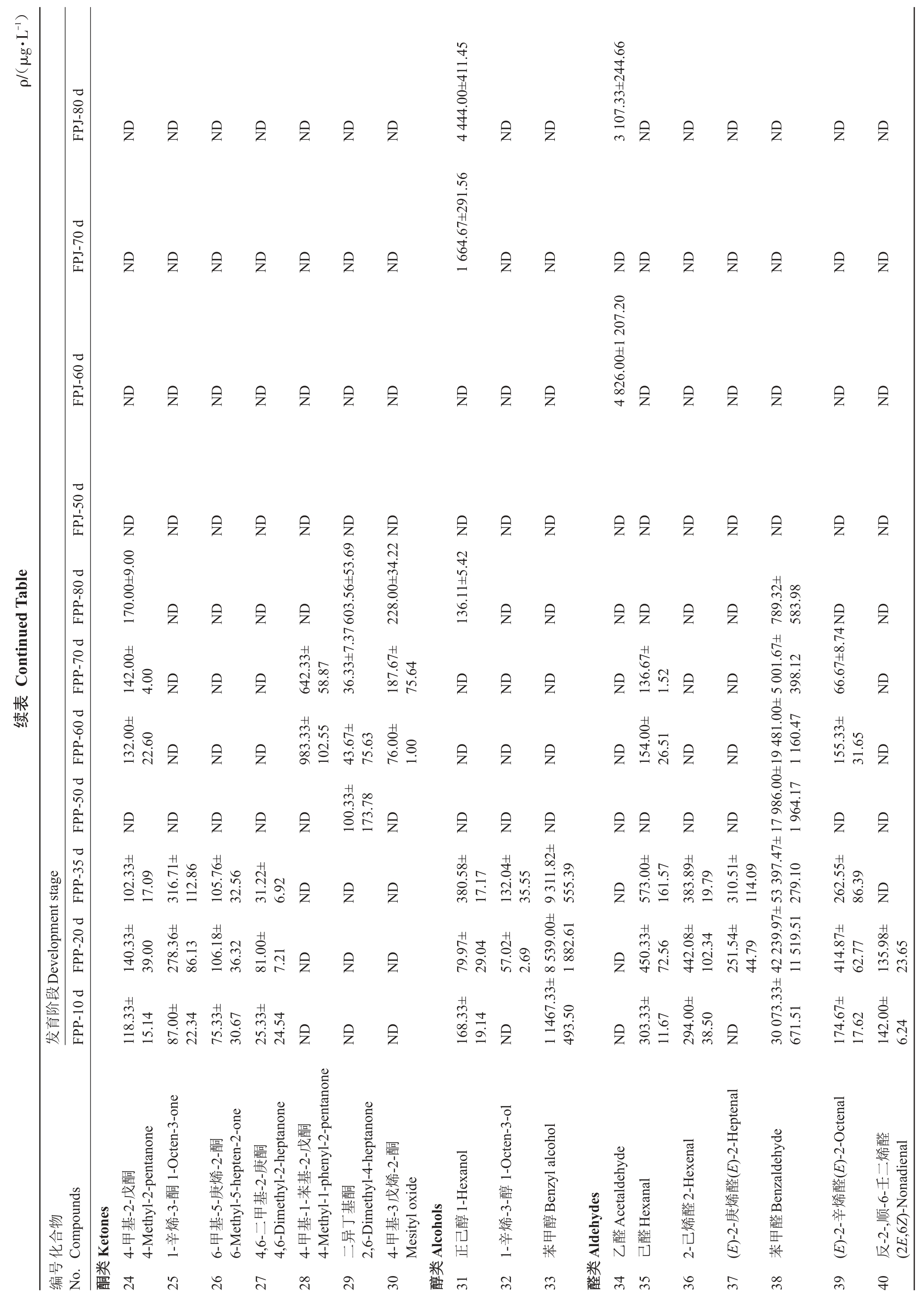
?
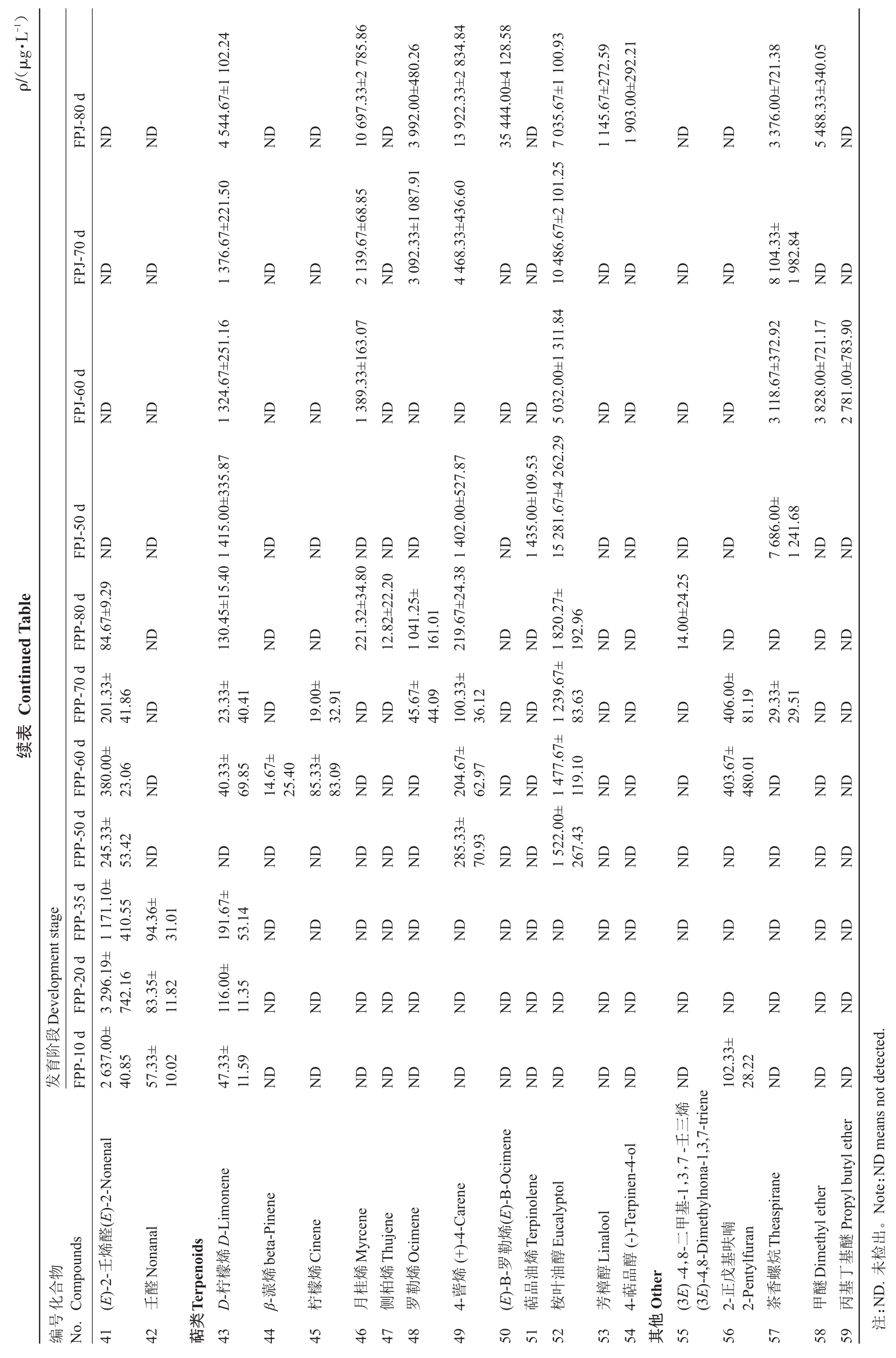
?
幼果期黄金百香果果皮(FPP-10 d~FPP-35 d)共检出20 种挥发性成分,含量从高到低依次为醛类、醇类、酯类、酮类、萜类、其他类物质,其中醛类物质占79.08%,主要包括苯甲醛、(E)-2-壬烯醛、己醛等;醇类物质占18.22%,以苯甲醇、正己醇为主;酯类主要包含水杨酸甲酯、苯甲酸甲酯、3,3,4,4-四甲基丁内酯。着色期黄金百香果果皮(FPP-50 d)共检出5种挥发性成分,主要包括醛类、萜类、酮类等物质,以苯甲醛、桉叶油醇为主。成熟期黄金百香果果皮(FPP-60 d~FPP-70 d)共鉴定出17种挥发性成分,主要包括醛类、萜类、酮类等物质,其中醛类物质占74.74%,主要包含苯甲醛、(E)-2-壬烯醛、己醛、(E)-2-辛烯醛;萜类物质占12.35%,以桉叶油醇为主;酮类物质含有4种成分,包括4-甲基-2-戊酮、4-甲基-1-苯基-2-戊酮、二异丁基酮、4-甲基-3 戊烯-2-酮。完全成熟期黄金百香果果皮(FPP-80 d)鉴定出16种挥发性成分,主要包含萜类、酮类、酯类等物质。萜类物质占57.04%,以桉叶油醇、罗勒烯为主;酮类物质占16.80%,以二异丁基酮、4-甲基-3戊烯-2-酮为主;酯类物质占9.73%,包含3-巯基己醇丁酸酯、乙酸乙酯、3,3,4,4-四甲基丁内酯。
黄金百香果果肉共检出33种挥发性成分,含量从高到低依次为酯类、萜类、其他类、醛类、醇类物质。其中酯类物质占82.69%,有19 种酯类物质,主要包含正己酸乙酯、丁酸乙酯、乙酸乙酯、乙酸己酯、乙酸叶醇酯等,其中乙酸叶醇酯仅在完全成熟百香果果肉(FPJ-80 d)中检出;萜类物质有9 种,主要包含桉叶油醇、月桂烯、4-蒈烯、D-柠檬烯、(E)-B-罗勒烯等,随着坐果时间增加,月桂烯含量逐渐增多,(E)-B-罗勒烯、芳樟醇及4-萜品醇仅在完全成熟期百香果果肉中检出;其他类物质有3种,以茶香螺烷为主;醛类物质仅有1 种,为乙醛;醇类物质仅有1种,为正己醇。
2.2 不同发育阶段黄金百香果挥发性成分种类及含量变化分析
由图1-A可知,从种类数量上分析,随着坐果时间增加,黄金百香果果皮中挥发性成分种类呈减少趋势,果肉中挥发性成分种类呈增多趋势。果皮中醛类物质种类高于果肉,其中幼果期果皮(FPP-10 d~FPP-35 d)中醛类物质种类较多。果皮中酮类物质种类显著多于果肉,果肉中酯类物质种类显著高于果皮,其中完全成熟期百香果果肉(FPJ-80 d)中酯类物质种类最多。着色期黄金百香果果皮及果肉挥发性成分种类明显少于其他发育时期。
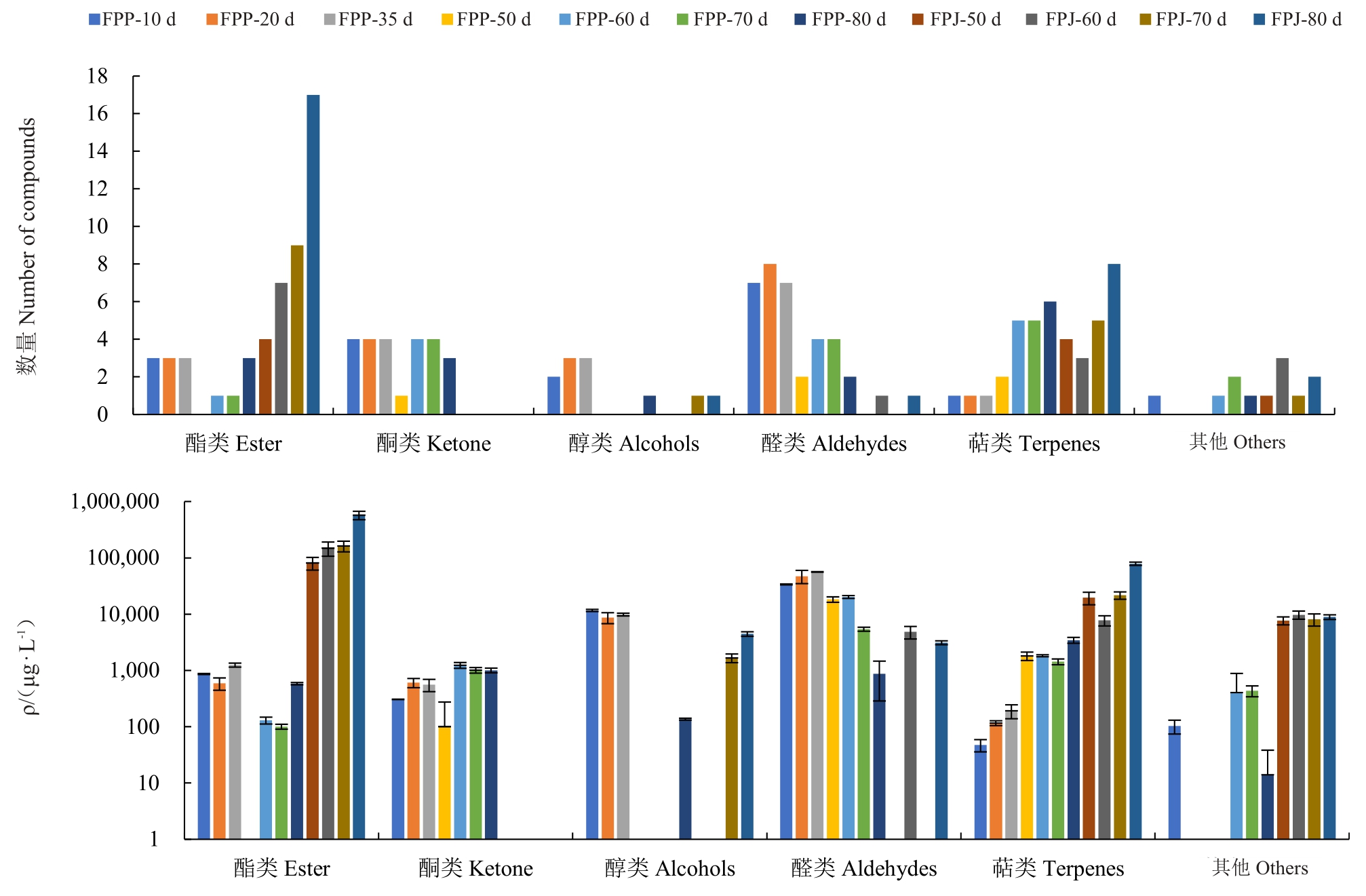
图1 不同发育阶段黄金百香果挥发性物质的数量(A)及含量(B)
Fig.1 Numbers(A)and contents(B)of volatile components in Golden Passion Fruit at different development stages
由图1-B 可以看出,在果皮中醛类和醇类挥发物含量较多,随着坐果时间增加,醛类含量先增加而后减少,坐果后35 d时,醛类含量达到最高,醛类物质含量在873.99~56 192.89 μg·L-1之间;醇类次之,含量在136.11~11 635.67 μg·L-1之间。从着色期至完全成熟期,果肉中酯类物质含量逐渐增多,含量在81 060.00~572 709.33 μg·L-1之间;萜类物质次之,含量在7 746.00~78 684.67 μg·L-1之间。在发育期内,果肉中挥发性成分含量不断增多。结果表明,不同发育阶段黄金百香果果皮和果肉挥发性成分种类及含量差别较大。
2.3 不同发育阶段黄金百香果挥发物成分聚类分析
对不同发育阶段黄金百香果挥发物成分进行聚类分析,结果见图2,可分为四类。坐果后10~35 d黄金百香果果皮(FPP-10 d ~FPP-35 d)为被聚一类,是因为幼果期果皮主要特征挥发物醛类、醇类等物质含量较高;坐果后50~80 d 黄金百香果果皮(FPP-50 d ~FPP-80 d)被聚为一类,是由于着色期至完全成熟期黄金百香果果皮主要特征挥发物为酮类物质,在其他样品中未检出或含量较低;坐果后50~70 d 黄金百香果果肉(FPJ-50 d ~FPJ-70 d)被聚为一类,是由于这些发育阶段的黄金百香果果肉主要挥特征发物成分为茶香螺烷等物质;坐果后80 d 黄金百香果果肉(FPJ-80 d)单独被聚为一类,主要是因为酯类、萜类物质等在完全成熟阶段黄金百香果果肉中显著积累,与其他样品差异较大。结果表明,黄金百香果果皮与果肉主要特征挥发物成分差异明显。

图2 不同发育阶段黄金百香果挥发性物质聚类热图
Fig.2 The cluster heatmap of volatile components in Golden Passion Fruit at different development stages
2.4 不同发育阶段黄金百香果挥发性成分主成分分析(PCA)
主成分分析(principal component analysis,PCA)是一种统计学分析手段,在判别分析上具有广泛的应用[21-24]。为了更加直观分析不同发育阶段黄金百香果挥发性物质差异,利用主成分分析,结果如图3 所示。在置信区间95%情况下,黄金百香果果皮挥发性成分主成分1和主成分2的贡献率分别为86.20%、6.87%,总贡献率为93.07%,黄金百香果果肉挥发性成分主成分1和主成分2的贡献率分别为87.10%、7.74%,总贡献率为94.84%,说明两组PCA分析解释度良好。幼果期与其他发育阶段黄金百香果果皮分布在纵轴两端,说明这两组样品间挥发物成分差异较大。完全成熟期与其他发育阶段黄金百香果果肉挥发物差异明显。
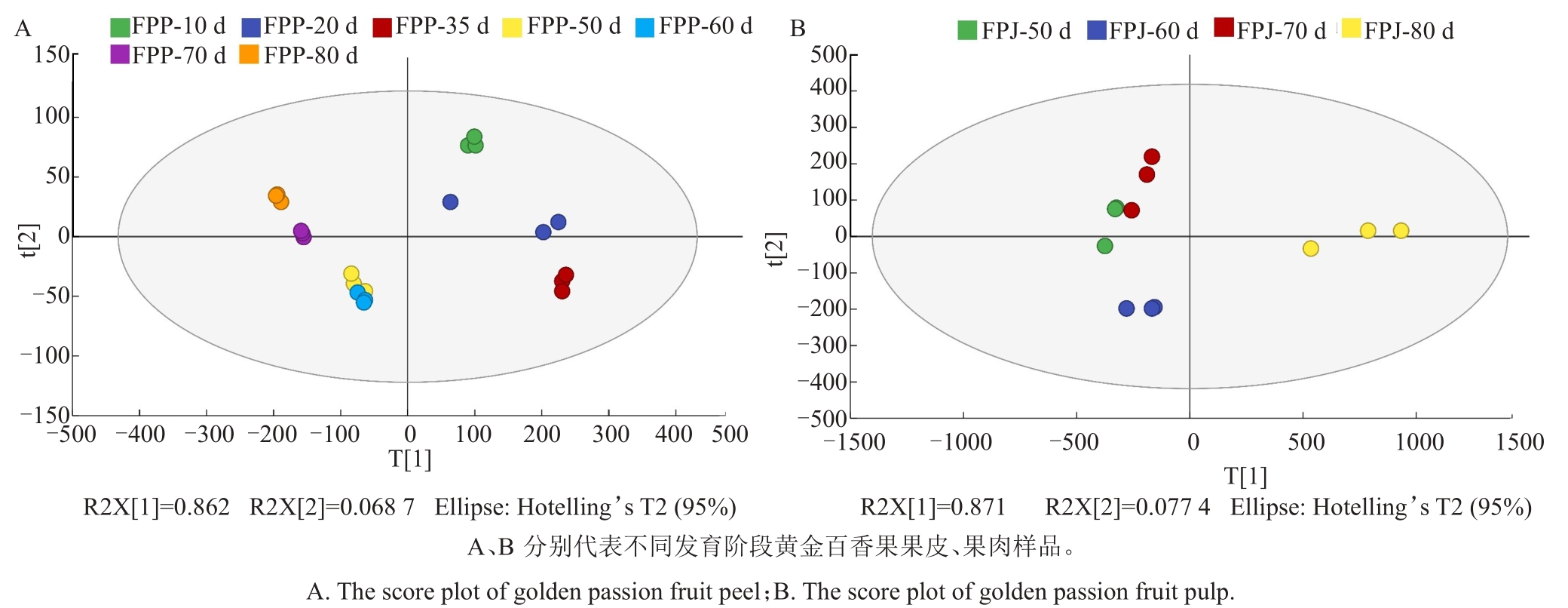
图3 PCA 结果
Fig.3 Principal component analysis(PCA)results
2.5 不同发育阶段黄金百香果挥发性成分正交偏最小二乘判别分析(OPLS-DA)
为了在分析过程中进一步使不同样品间的差异最大化,利用正交偏最小二乘判别分析(Orthogonal partial least squares discriminant analysis,OPLS-DA)并建立模型[25]。图4为不同发育阶段黄金百香果果皮挥发性成分OPLS-DA 结果。OPLS-DA 得分图(图4-A)的R2Y(cum)值为0.916,Q2(cum)值为0.798,表明该模型稳定性良好,可以应用于差异挥发物成分的筛选。通过对该OPLS-DA 模型的VIP值进行多变量分析,对VIP 值进行排序,VIP 值越大,则对模型的贡献度越高[26],筛选出VIP值≥1的挥发性成分。由图4-B可知,共有6种挥发物成分VIP值>1(挥发物编号与表1 一致),依次为苯甲醛(38)、苯甲醇(33)、(E)-2-壬烯醛(41)、4-甲基-1-苯基-2-戊酮(28)、罗勒烯(48)、桉叶油醇(52)。同时引入S-plot图进一步探究贡献变量指标,在“S”曲线上下两端、远离原点的变量对模型的贡献率较高,结合图4-C各变量指标分布情况,发现苯甲醛(38)、苯甲醇(33)、(E)-2-壬烯醛(41)、桉叶油醇(52)分布在S-plot 图“S”曲线上下两端,说明苯甲醛、苯甲醇、(E)-2-壬烯醛及桉叶油醇为幼果期与其他发育阶段黄金百香果果皮的特征差异挥发性成分,幼果期与其他发育阶段黄金百香果果皮相比,苯甲醛、苯甲醇及(E)-2-壬烯醛含量显著高,桉叶油醇含量显著低。完全成熟期与其他发育阶段相比,罗勒烯含量显著高,罗勒烯为完全成熟期与其他发育阶段黄金百香果果皮的特征差异挥发性成分,果皮中罗勒烯可用作判别黄金百香果完全成熟的关键挥发性成分特征指标。
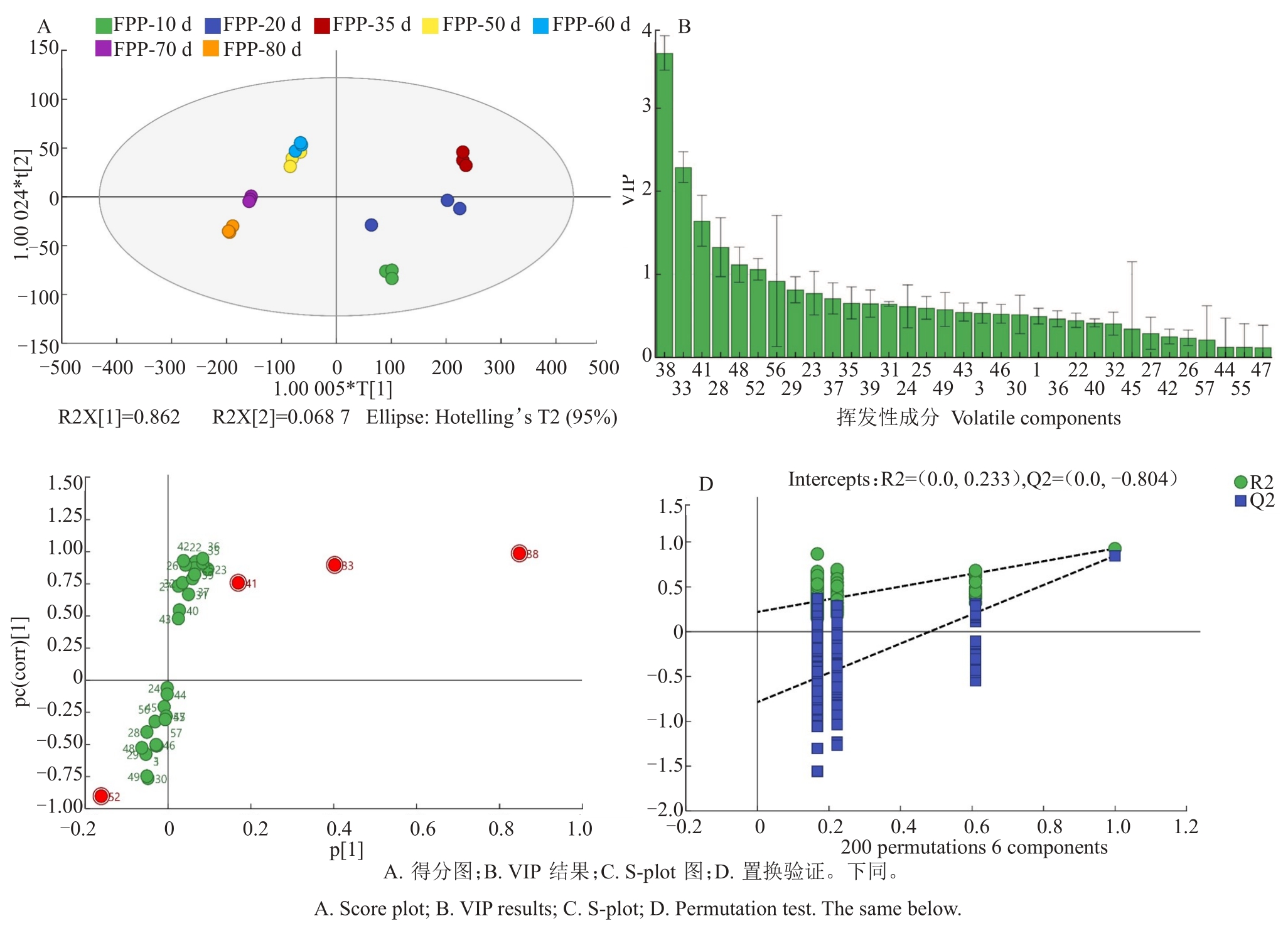
图4 不同发育阶段黄金百香果果皮挥发性成分OPLS-DA 结果
Fig.4 OPLS-DA results of volatile components in Golden Passion Fruit peel at different development stages
黄金百香果果肉挥发性成分OPLS-DA 得分图(图5-A)的R2Y(cum)值为0.976,Q2(cum)值为0.926,该模型稳定性良好。由图5-B可知,总共有7种挥发性成分VIP值>1,依次为正己酸乙酯(9)、乙酸己酯(13)、(E)-3-己烯-1-醇乙酸酯(11)、丁酸乙酯(5)、桉叶油醇(52)、(E)-B-罗勒烯(50)、乙酸叶醇酯(12)。结合S-plot图(图5-C)各变量指标分布情况,发现正己酸乙酯(9)、乙酸己酯(13)、(E)-B-罗勒烯(50)、乙酸叶醇酯(12)分布在“S”曲线上下两端,说明正己酸乙酯、乙酸己酯、(E)-B-罗勒烯及乙酸叶醇酯为完全成熟期与其他发育阶段黄金百香果果肉的特征差异挥发性成分,完全成熟黄金百香果果肉中正己酸乙酯、乙酸己酯、(E)-B-罗勒烯及乙酸叶醇酯含量显著高于其他发育阶段,因此可以将这4 种挥发性成分含量,用来作为判别黄金百香果完全成熟的关键挥发性成分特征指标。
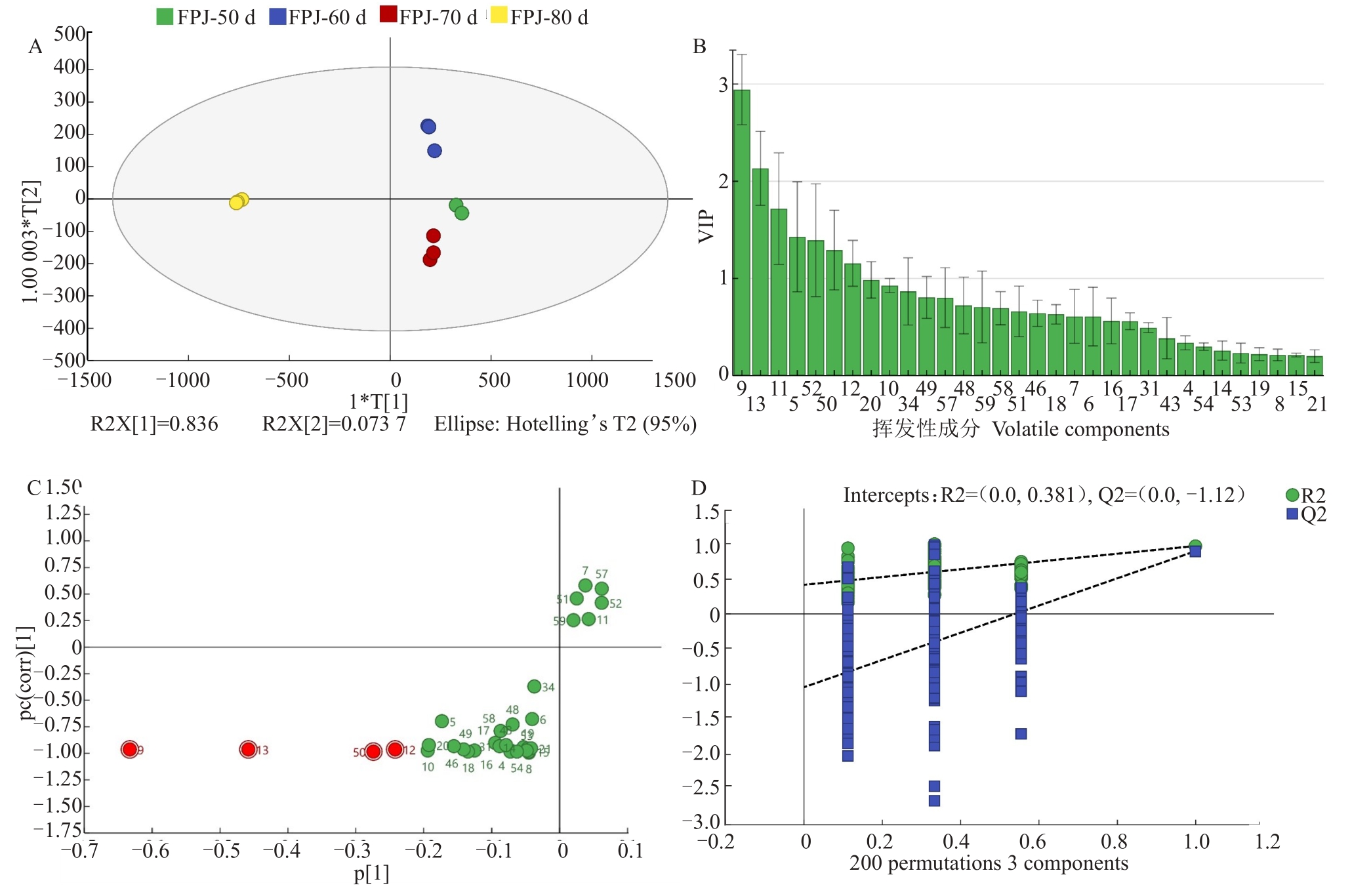
图5 不同发育阶段黄金百香果果肉挥发性成分OPLS-DA 结果
Fig.5 OPLS-DA results of volatile components in Golden Passion Fruit pulp at different development stages
为了验证模型的有效性,对这2 个模型分别进行了200 次置换验证检验(图4-D、图5-D),结果表明这两个OPLS-DA 模型没有过拟合,具有统计学意义。
3 讨 论
3.1 黄金百香果发育阶段挥发性成分种类与含量特征
百香果从发育到成熟的过程是一系列复杂的代谢变化过程,代谢变化决定了挥发性成分变化,因此百香果挥发性成分在发育过程中呈动态变化。根据百香果发育特征变化,分为幼果期、着色期、成熟期、完全成熟期4个阶段。幼果期黄金百香果果皮挥发物种类多于其他时期,成分较复杂;从幼果期向着色期发育过程中,挥发物种类明显减少,醛类、醇类挥发物明显减少;从着色期至完全成熟期,黄金百香果果皮挥发物种类增加,特别是单萜类挥发物,黄金百香果果肉挥发物种类也逐渐增加,酯类、萜类挥发物明显增多,这些挥发物对成熟黄金百香果的香气形成具有重要的意义。
幼果期黄金百香果果皮挥发物含量明显比其他发育时期增多,幼果期后黄金百香果果皮挥发物含量呈下降趋势,挥发物特征有明显变化,这可能是由幼果期后,果实进入快速生长期,香气代谢进入过渡期,醛类、醇类物质代谢反应相对滞后造成的。从着色期至完全成熟期,黄金百香果果肉挥发物含量呈上升趋势,完全成熟期时达到最大值,果肉中挥发物的生成速率有所提升,挥发物含量升高,黄金百香果香气特征基本形成。
3.2 黄金百香果主要挥发性成分类型变化特征
幼果期黄金百香果果皮挥发性成分以醛类、醇类为主,特别是苯甲醛、苯甲醇等,苯甲醛及其衍生物苯甲醇具有苦杏仁味、果香味,主要由百香果中苦杏仁苷经过酶解产生,是植物在抵御伤害过程中的重要产物[30],可能是黄金百香果在幼果期抵御病虫等伤害,果皮主要代谢产生苯甲醛等物质。
萜类物质多数存贮于成熟期后,研究表明,萜类挥发物与昆虫取食、传粉、防御或应激反应有关,α-古巴烯、β-石竹烯等可作为重要的引诱剂应用于害虫防治[27]。萜类物质,如月桂烯、(E)-B-罗勒烯等,参与果实花香气形成,香气特征明显,且阈值较低,对风味影响较大[28]。
除了着色期黄金百香果果皮,酯类物质广泛分布于各个发育阶段,在黄金百香果果肉中含量较高,成熟期后酯类物质含量均达到80%以上,酯类是果香味香气的主要挥发性成分,在果实成熟过程中发挥着重要的作用。
3.3 主要挥发性成分代谢机制
C6、C9醛类物质,如(E)-2-壬烯醛、2-己烯醛、壬醛等,是在脂肪酸代谢途径产生[29],是以亚油酸、亚麻酸为底物经过脂氧合酶(Lipoxygenase,LOX)作用代谢生成,进一步经醇脱氢酶(Alcohol dehydrogenase,ADH)的作用可形成相应的醇类物质。苯甲醛、苯甲醇等芳香醛、醇类挥发物主要是经过氨基酸代谢途径生成,在转氨酶的作用下,经脱羧酶作用生成醛,再经醇脱氢酶作用生成相应的醇[30]。幼果期后,脂氧合酶活性减弱,醛类物质合成减少[31]。
萜类物质是以香叶基二磷酸(Geraniyldiphosphate,GDP)和法尼基二磷酸(Farnesyldiphosphate,FDP)作为底物,在萜类合成酶和环化酶的作用下形成萜烯骨架,再经过一系列酶修饰成为萜类物质。本试验中共检出12 种萜类物质,着色期后,黄金百香果果肉中萜类物质数量及含量均增加,由于酶活性提高,代谢活跃,上调了萜类物质生物合成[30],且萜类物质香气阈值较低,对黄金百香果成熟果实香气贡献度较高。(E)-B-罗勒烯、芳樟醇、4-萜品醇等萜类仅在完全成熟期黄金百香果果肉中检出,这些多数为单萜类物质,主要是由于这些单萜类物质经饱和脂肪酸β-氧化形成[32],说明完全成熟后百香果果实中饱和脂肪酸含量增加,萜类代谢较活跃。
酯类物质是在醇酰基转移酶(Alcohol acyltransferases,AATs)作用下形成[29],着色期后,直链酯,如己酸乙酯、乙酸己酯、乙酸乙酯、丁酸乙酯、己酸己酯、辛酸乙酯等,主要由饱和脂肪酸经β-氧化形成,发育期下饱和脂肪酸含量增加,β-氧化活性增强,强烈地上调了酯类物质的生物合成。大部分酯类物质出现在成熟期后黄金百香果果肉中,表明这些挥发物对于黄金百香果成熟过程中香气形成具有重要意义,百香果挥发性成分的产生依赖于果实成熟[5],大部分挥发性成分在黄金百香果发育初期积累,在果实成熟时达到峰值。
3.4 正交偏最小二乘判别分析
利用正交偏最小二乘判别分析,发现幼果期与其他发育阶段黄金百香果果皮相比,幼果期黄金百香果果皮中苯甲醛、苯甲醇及(E)-2-壬烯醛含量显著高,桉叶油醇含量显著低。苯甲醇具有甜香、花香[33],苯甲醛具有樱桃、苦杏仁香味,(E)-2-壬烯醛具有黄瓜、脂肪味道,桉叶油醇有樟脑气息和清凉的草药味道,具有杀菌、杀虫等作用,多用于医药和食品香料,为重要药用成分。黄金百香果果皮具有一定的经济价值。完全成熟的黄金百香果果肉中正己酸乙酯、乙酸己酯、(E)-B-罗勒烯及乙酸叶醇酯含量显著高于其他发育阶段百香果果肉,正己酸乙酯具有菠萝、浆果味道,乙酸己酯具有梨、浆果香气,(E)-B-罗勒烯具有草香香气,乙酸叶醇酯具有青香蕉味,这些物质具有明显的果香、草香味,对于完全成熟的黄金百香果典型香气特征具有重要贡献[30]。(E)-B-罗勒烯及乙酸叶醇酯仅在完全成熟黄金百香果中特异生成,而在其他发育阶段黄金百香果果实中不存在,这一结果表明,这两种挥发性成分可能是黄金百香果完全成熟的信号,或作为在黄金百香果完全成熟后防御伤害或者吸引种子传播的策略[16]。由此可见,这些差异表达的挥发性成分对黄金百香果香气形成及变化至关重要。
4 结 论
不同发育阶段黄金百香果挥发性成分差异较大,代谢途径的变化决定了黄金百香果挥发性成分变化,幼果期内黄金百香果挥发物成分的产生可能与植物防御伤害等反应有关,着色期后,在饱和脂肪酸β-氧化代谢途径下出现直链酯类物质,这些酯类物质对于黄金百香果成熟过程中香气形成具有重要意义。醛类、醇类、萜类、酯类等物质相互作用,构成黄金百香果不同发育阶段的独特风味。苯甲醛、苯甲醇、(E)-2-壬烯醛及桉叶油醇是幼果期与其他发育时期黄金百香果果皮特征差异挥发性成分,罗勒烯为完全成熟期黄金百香果果皮的特征挥发性成分。正己酸乙酯、乙酸己酯、(E)-B-罗勒烯及乙酸叶醇酯为完全成熟黄金百香果果肉特征挥发性成分。
[1]MAMEDE A M G N,SOARES A G,OLIVEIRA E J,FARAH A. Volatile composition of sweet passion fruit (Passiflora alata Curtis)[J]. Journal of Chemistry,2017:3497216. DOI:10.1155/2017/3497216.
[2]郭艳峰,吴惠婵,夏雨,杨得坡,张延杰.百香果不同发育阶段果汁挥发性成分研究[J].福建农业学报,2017,32(3):299-304.GUO Yanfeng,WU Huichan,XIA Yu,YANG Depo,ZHANG Yanjie.Volatiles in juice of passion fruitsat different developmental stages[J]. Fujian Journal of Agricultural Sciences,2017,32(3):299-304.
[3]PORTO-FIGUEIRA P,FREITAS A,CRUZ C J,FIGUEIRA J,CAMARA J S. Profiling of passion fruit volatiles:An effective tool to discriminate between species and varieties[J]. Food Research International,2015,77:408-418.
[4]李程勋,李爱萍,徐晓俞,郑开斌.百香果果皮精油提取及香气成分分析[J].福建农业学报,2019,34(4):495-501.LI Chengxun,LI Aiping,XU Xiaoyu,ZHENG Kaibin.Extraction and aromatics of essential oil from passion fruit peels[J].Fujian Journal of Agricultural Sciences,2019,34(4):495-501.
[5]WU Q,TAO X Y,AI X Z,LUO Z S,MAO L C,YING T J,LI L.Effect of exogenous auxin on aroma volatiles of cherry tomato(Solanum lycopersicum L.)fruit during postharvest ripening[J].Postharvest Biology and Technology,2018,146:108-116.
[6]ZHANG Y Y,LIU W J,ZHANG B B,ZHANG Y Y,CAI Z X,SONG H F,MA R J,YU M L.Analysis of volatile compounds and their potential regulators in four high-quality peach (Prunus persica L.) cultivars with unique aromas[J]. LWT-Food Science and Technology,2022,160:113195. DOI:10.1016/J.LWT.2022.113195.
[7]ALEGRE Y,SAENZ-NAVAJAS M P,HERNANDEZ-ORTE P,FERREIRA V. Sensory,olfactometric and chemical characterization of the aroma potential of Garnacha and Tempranillo winemaking grapes[J]. Food Chemistry,2020,331:127207.DOI:10.1016/j.foodchem.2020.127207.
[8]NIU Y W,DENG J M,XIAO Z B,ZHU J C. Characterization of the major aroma-active compounds in peach [Prunus persica(L.) Batsch]by gas chromatography-olfactometry,flame photometric detection and molecular sensory science approaches[J].Food Research International,2021,147:110457. DOI:10.1016/J.FOODRES.2021.110457.
[9]ZHANG H P,XIE Y X,LIU C H,CHEN S L,HU S S,XIE Z Z,DENG X X,XU J. Comprehensive comparative analysis of volatile compounds in citrus fruits of different species[J]. Food Chemistry,2017,230:316-326.
[10]WERKHOFF P,GUNTERT M,KRAMMER G,SOMMER H,KAULEN J. Vacuum headspace method in aroma research:flavor chemistry of yellow passion fruits[J].Journal of Agricultural and Food Chemistry,1998,46(3):1076-1093.
[11]张鹏英.番茄挥发性物质在不同发育时期的变化及其对寡糖诱导子响应的差异[D].济南:山东大学,2008.ZHANG Pengying.Effect of crop development on the emission of volatile from tomato leaf and their response to oligosaccharide[D].Jinan:Shandong University,2008.
[12]BRAGA G C,PRADO A,DA SILVA P J S,ALENCAR S M.Volatile profile of yellow passion fruit juice by static headspace and solid phase microextraction techniques[J]. Ciencia Rural,2015,45(2):356-363.
[13]韩素芳,丁明,刘亚群,陈顺伟,王丽霞.顶空固相微萃取-气相色谱-质谱测定百香果香气条件的优化[J]. 中国食品学报,2010,10(4):278-284.HAN Sufang,DING Ming,LIU Yaqun,CHEN Shunwei,WANG Lixia.The optimization of determination condition of passion fruit odors by SPME-GC-MS[J]. Journal of Chinese Institute of Food Science and Technology,2010,10(4):278-284.
[14]JANZANTTI N S,MONTEIRO M.Changes in the aroma of organic passion fruit (Passiflora edulis Sims f. flavicarpa Deg.)during ripeness[J]. LWT- Food Science and Technology,2014,59(2):612-620.
[15]LEAO K M M,SAMPAIO K L,PAGANI A A C,DA SILVA M A A P.Odor potency,aroma profile and volatiles composition of cold pressed oil from industrial passion fruit residues[J]. Industrial Crops and Products,2014,58:280-286.
[16]LI C B,XIN M,LI L,HE X M,YI P,TANG Y Y,LI J M,ZHENG F J,LIU G M,SHENG J F,LI Z C,SUN J. Characterization of the aromatic profile of purple passion fruit (Passiflora edulis Sims)during ripening by HS-SPME-GC/MS and RNA sequencing[J].Food Chemistry,2021,355:129685.DOI:10.1016/J.FOODCHEM.2021.129685.
[17]潘葳,刘文静,韦航,罗钦,韦晓霞.不同品种百香果果汁营养与香气成分的比较[J].食品科学,2019,40(22):277-286.PAN Wei,LIU Wenjing,WEI Hang,LUO Qin,WEI Xiaoxia.Comparative analysis of nutritional and aroma components in passion fruit juices from five cultivars[J]. Food Science,2019,40(22):277-286.
[18]OLIVEIRA P N,GOMES P C D S,ALCARDE A R,BORTOLETTO A M,NETA M T S L,NARAIN N,ABUD A K D S.Characterization and volatile profile of passion fruit spirit[J]. International Journal of Gastronomy and Food Science,2020,21:100223.DOI:10.1016/j.ijgfs.2020.100223.
[19]杨琴,俞露,赵芷,池继焰,谭书明.植物生长调节剂对百香果的影响[J].中国农学通报,2021,37(19):58-64.YANG Qin,YU Lu,ZHAO Zhi,CHI Jiyan,TAN Shuming.Effects of plant growth regulators on Passiflora edulia[J]. Chinese Agricultural Science Bulletin,2021,37(19):58-64.
[20]刘纯友,江素珍,冯笑,田玉红.HS-SPME-GC-MS 测定三种类型百香果果实挥发性风味成分[J]. 食品工业科技,2021,42(11):255-262.LIU Chunyou,JIANG Suzhen,FENG Xiao,TIAN Yuhong.Study on volatile flavor compounds from three types of passion fruit using headspace solid phase micro-extraction gas chromatography mass spectrometry[J]. Science and Technology of Food Industry,2021,42(11):255-262.
[21]LENG P,HU H W,CUI A H,TANG H J,LIU Y G. HS-GCIMS with PCA to analyze volatile flavor compounds of honey peach packaged with different preservation methods during storage[J]. LWT- Food Science and Technology,2021,149:111963.DOI:10.1016/J.LWT.2021.111963.
[22]YANG Y,WANG B,FU Y,SHI Y G,CHEN F L,GUAN H N,LIU L L,ZHANG C Y,ZHU P Y,LIU Y,ZHANG N. HS-GCIMS with PCA to analyze volatile flavor compounds across different production stages of fermented soybean whey tofu[J].Food Chemistry,2021,346:128880. DOI:10.1016/J.FOODCHEM.2020.128880.
[23]LI M Q,YANG R W,ZHANG H,WANG S L,CHEN D,LIN S Y. Development of a flavor fingerprint by HS-GC-IMS with PCA for volatile compounds of Tricholoma matsutake Singer[J].Food Chemistry,2019,290:32-39.
[24]沈植国,孙萌,袁德义,程建明,丁鑫,尚忠海.蜡梅科6 种植物嫩梢挥发性成分的HS-SPME-GC-MS 分析[J].园艺学报,2020,47(12):2349-2361.SHEN Zhiguo,SUN Meng,YUAN Deyi,CHENG Jianming,DING Xin,SHANG Zhonghai.HS-SPME-GC-MS analysis of volatile components in tender shoots from six plants of calycanthaceae[J].Acta Horticulturae Sinica,2020,47(12):2349-2361.
[25]范威威,林熙,龚霄,周伟,李积华,孔智文,苏波,李扬宇.基于顶空气相-离子迁移谱技术对不同酵母发酵的百香果果啤香气比较[J].食品工业科技,2022,43(7):325-332.FAN Weiwei,LIN Xi,GONG Xiao,ZHOU Wei,LI Jihua,KONG Zhiwen,SU Bo,LI Yangyu.Aroma comparison of passion beer fermented by different yeasts based on headspace phase- ion mobility spectroscopy technology[J]. Science and Technology of Food Industry,2022,43(7):325-332.
[26]高嘉宁,张丹,何海燕,曹龙武.基于正交偏最小二乘判别分析法分析滇重楼和华重楼品质成分差异性[J].应用与环境生物学报,2019,25(1):136-142.GAO Jianing,ZHANG Dan,HE Haiyan,CAO Longwu.Difference in quality components of Paris polyphylla var.yunnanensis and P. polyphylla var. chinensis based on the orthogonal partial least squares discriminant analysis model[J]. Chinese Journal of Applied and Environmental Biology,2019,25(1):136-142.
[27]KENDRA P E,MONTGOMERY W S,DEYRUP M A,WAKARCHUK D.Improved lure for redbay ambrosia beetle developed by enrichment of α-copaenecontent[J].Journal of Pest Science,2016,89(2):427-438.
[28]SCHWAB W,DAVIDOVICH-RIKANATI R,LEWINSOHN E.Biosynthesis of plant-derived flavor compounds[J]. Plant Journal,2008,54(4):712-732.
[29]王欢欢,马越,白冰,王宇滨,赵晓燕,张超.番茄果实呈香组分及其代谢途径研究进展[J].中国瓜菜,2018,31(12):1-4.WANG Huanhuan,MA Yue,BAI Bing,WANG Yubin,ZHAO Xiaoyan,ZHANG Chao.Progress of aroma volatiles of tomato fruit and their metabolic pathway[J].Chinese Cucurbits and Vegetables,2018,31(12):1-4.
[30]李晓颍,武军凯,王海静,李梦园,申艳红,刘建珍,张立彬.欧李果实发育期内挥发性成分变化特征[J]. 中国农业科学,2021,54(9):1964-1980.LI Xiaoying,WU Junkai,WANG Haijing,LI Mengyuan,SHEN Yanhong,LIU Jianzhen,ZHANG Libin.Characterization of volatiles changes in chinese dwarf cherry fruit during its development[J].Scientia Agricultura Sinica,2021,54(9):1964-1980.
[31]张克坤,王海波,王孝娣,史祥宾,王宝亮,郑晓翠,刘凤之.‘瑞都香玉’葡萄果实挥发性成分在果实发育过程中的变化[J].中国农业科学,2015,48(19):3965-3978.ZHANG Kekun,WANG Haibo,WANG Xiaodi,SHI Xiangbin,WANG Baoliang,ZHENG Xiaocui,LIU Fengzhi.Evolution of volatile compounds during the berry development of‘Ruidu Xiangyu’grape[J]. Scientia Agricultura Sinica,2015,48(19):3965-3978.
[32]BRANDI F,BAR E,MOURGUES F,HORVÁTH G,TURCSI E,GIULIANO G,ROSATI C. Study of‘Redhaven’peach and its white-fleshed mutant suggests a key role of CCD4 carotenoid dioxygenase in carotenoid and norisoprenoid volatile metabolism[J].BMC Plant Biology,2011,11(1):24.
[33]安会敏,欧行畅,熊一帆,张杨波,李娟,李勤,李骞,李适,黄建安. 茉莉花茶特征香气成分研究[J]. 茶叶科学,2020,40(2):225-237.AN Huimin,OU Xingchang,XIONG Yifang,ZHANG Yangbo,LI Juan,LI Qin,LI Qian,LI Shi,HUANG Jian’an.Study on the characteristic aroma components of jasmine tea[J]. Journal of Tea Science,2020,40(2):225-237.